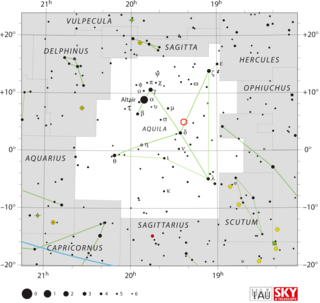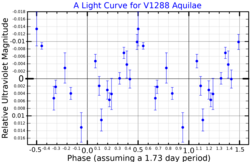
V1494 Aquilae or Nova Aquilae 1999 b was a nova which occurred during 1999 in the constellation Aquila and reached a brightness of magnitude 3.9 on 2 December 1999. making it easily visible to the naked eye. The nova was discovered with 14×100 binoculars by Alfredo Pereira of Cabo da Roca, Portugal at 18:50 UT on 1 December 1999, when it had a visual magnitude of 6.0.

Eta Aquilae is a multiple star in the equatorial constellation of Aquila, the eagle. It was once part of the former constellation Antinous. Its apparent visual magnitude varies between 3.49 and 4.3, making it one of the brighter members of Aquila. Based upon parallax measurements made by the Gaia spacecraft on its third data release (DR3), this star is located at a distance of roughly 272 parsecs. The primary component is a Classical Cepheid variable.

Phi Aquilae, Latinized from φ Aquilae, is the Bayer designation of a binary star system in the equatorial constellation of Aquila. It has an apparent visual magnitude of +5.28 and is visible to the naked eye. With an annual parallax shift of 14.198 mas, this star is located at a distance of approximately 230 light-years from Earth. It is drifting closer with a radial velocity of –27 km/s. Based on its motion through space, this system is considered a possible member of the nearby Argus association of co-moving stars, although it may be too old.

Psi Aquilae, Latinized as ψ Aquilae, is the Bayer designation for a star in the equatorial constellation of Aquila. It is a faint star with an apparent visual magnitude of 6.25, which, according to the Bortle Dark-Sky Scale, can be seen with the naked eye in dark rural skies. The orbit of the Earth causes an annual parallax shift of 2.83 mas, which indicates a distance of approximately 1,150 light-years.
70 Aquilae, abbreviated 70 Aql, is a single orange-hued star in the equatorial constellation of Aquila. 70 Aquilae is its Flamsteed designation. It is visible to the naked eye with an apparent visual magnitude of 4.90. The distance to 70 Aquilae, as determined from its annual parallax shift of 3.5 mas, is around 940 light years. The star is moving closer to the Earth with a heliocentric radial velocity of −9 km/s.
4 Aquilae, abbreviated 4 Aql, is a single, white-hued star in the equatorial constellation of Aquila. 4 Aquilae is the Flamsteed designation. It has an apparent visual magnitude of 5.02, making it a faint star visible to the naked eye. The distance to 4 Aql can be estimated from its annual parallax shift of 6.7 mas, yielding an estimated range of around 480 light years. It is moving closer to the Earth with a heliocentric radial velocity of −13 km/s.
11 Aquilae is a single star in the equatorial constellation of Aquila. 11 Aquilae is the Flamsteed designation. It has an apparent visual magnitude of 5.2, which means it is faintly visible to the naked eye. Based upon an annual parallax shift of 20.9 mas, the distance to this star is approximately 156 light-years. The brightness of this star is diminished by 0.33 in magnitude because of extinction from interstellar gas and dust.

20 Aquilae, abbreviated 20 Aql, is an irregular variable star in the equatorial constellation of Aquila. 20 Aquilae is its Flamsteed designation. It ranges in magnitude from a peak of 5.33 down to 5.36, which is bright enough for the star to be visible to the naked eye. The estimated distance to this star is around 920 light years, based upon an annual parallax shift of 3.5 mas. The star is moving closer to the Earth with a heliocentric radial velocity of −23 km/s.

28 Aquilae, abbreviated 28 Aql, is a star in the equatorial constellation of Aquila. 28 Aquilae is its Flamsteed designation though it also bears the Bayer designation A Aquilae, and the variable star designation V1208 Aquilae. It has an apparent visual magnitude is 5.5, making this a faint star that requires dark suburban skies to view. The annual parallax shift of 9.6 mas means this star is located at a distance of approximately 340 light-years from Earth.

10 Aquilae is a star in the equatorial constellation of Aquila. 10 Aquilae is the Flamsteed designation. It has an apparent visual magnitude of 5.9 and thus is a faint star that is just visible to the naked eye in dark skies. The brightness of this star is diminished by 0.17 in visual magnitude from extinction caused by interstellar gas and dust. Based on an annual parallax shift of 13.45 mas, the distance to this star is around 240 light-years.
8 Aquilae is a star in the equatorial constellation of Aquila, located 271 light years away from the Sun. 8 Aquilae is the Flamsteed designation. It can be viewed with the naked eye in good seeing conditions, appearing as a dim, yellow-white hued star with an apparent visual magnitude of 6.08. The star is moving further from the Earth with a heliocentric radial velocity of +12 km/s.

R Aquilae is a variable star in the equatorial constellation of Aquila. It is located approximately 760 light years distant from the Sun and is drifting further away with a radial velocity of 35 km/s. This is a thermally-pulsating Mira variable that ranges in brightness from magnitude 5.3 down to 12.0 with a period of 269.84 days. The period was over 300 days when first observed, and has declined steadily since – decreasing from 320 in 1915 down to 264 in 2010, at an average rate of 0.4 days per year. The amplitude of the variation has also decreased by about a magnitude since discovery. The peak magnitude is bright enough for the star to be visible to the naked eye as a dim, red-hued star.

V Aquilae is a carbon star and semiregular variable star in the constellation Aquila. It has an apparent magnitude which varies between 6.6 and 8.4 and is located around 400 parsecs (1,300 ly) away.

FF Aquilae is a classical Cepheid variable star located in the constellation Aquila, close to the border with Hercules. It ranges from apparent magnitude 5.18 to 5.51 over a period of 4.47 days, meaning it is faintly visible to the unaided eye in rural or suburban settings.

V1291 Aquilae is a single star in the equatorial constellation of Aquila. It has a yellow-white hue and is dimly visible to the naked eye with an apparent visual magnitude that fluctuates around 5.65. Based on parallax measurements, it is located at a distance of approximately 278 light years from the Sun. The star it is drifting closer with a radial velocity of −22 km/s.

V923 Aquilae is a variable binary star system in the equatorial constellation of Aquila. It has the designation HD 183656 from the Henry Draper Catalogue; V932 Aql is the variable star designation. The system is dimly visible to the naked eye with an apparent visual magnitude that fluctuates around 6.06. It is located at a distance of approximately 890 light years from the Sun based on parallax, but is drifting closer with a radial velocity of around −26 km/s.

V1401 Aquilae is a single, semi-regular pulsating star in the equatorial constellation of Aquila. It has the designation HD 190390 from the Henry Draper Catalogue, and was formerly designated 64 Sagittarii. The evolutionary status of the star is unclear, and it has been classified as a post-AGB object, a UU Herculis variable, or belonging to the W Virginis variable subclass of the type II Cepheids. It is dimly visible to the naked eye with an apparent visual magnitude that fluctuates around 6.38. Based on parallax measurements, it is located at a distance of approximately 2,380 light years. It lies 21.5° from the galactic plane.

Omega2 Aquilae, Latinized from ω2 Aquilae, is the Bayer designation for a star in the equatorial constellation of Aquila, the eagle. It has an apparent visual magnitude of 6.0, which is close to the lower limit of detectability with the naked eye. According to the Bortle Dark-Sky Scale, this star can be viewed from dark rural skies. As the Earth orbits about the Sun, this star undergoes a parallax shift of 11.7 mas. This is equivalent to a physical distance of 279 light-years from Earth, give or take a 2 light year margin of error. The star is drifting closer to the Sun with a radial velocity of −26 km/s.
46 Aquilae is a star in the constellation of Aquila, located to the north of Tarazed. 46 Aquilae is its Flamsteed designation. It is a dim, blue-white hued star that is a challenge to view with the naked eye, having an apparent visual magnitude of 6.33. This object is located approximately 830 light years from the Sun, based on parallax. It is moving closer to the Earth with a heliocentric radial velocity of −25 km/s.
7 Aquilae is a star in the equatorial constellation of Aquila, located 359 light years away from the Sun. 7 Aquilae is the Flamsteed designation. It is visible to the naked eye as a faint, yellow-white hued star with a baseline apparent visual magnitude of 6.9. The star is moving closer to the Earth with a heliocentric radial velocity of −21 km/s.









